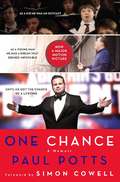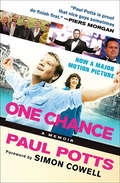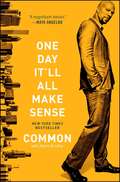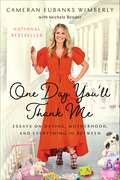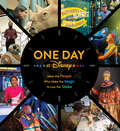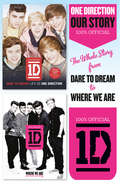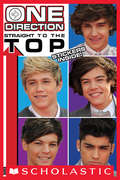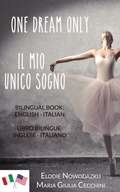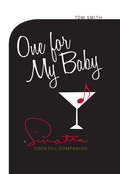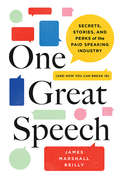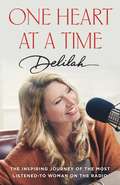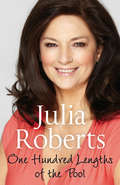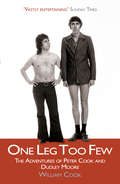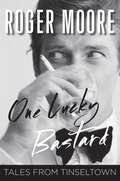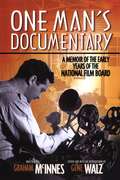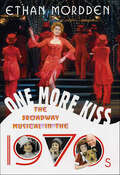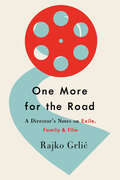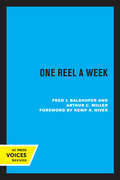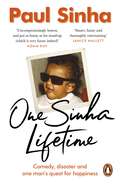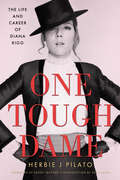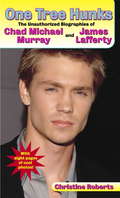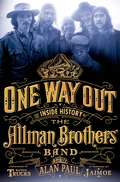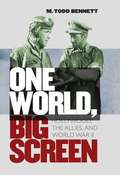- Table View
- List View
One Chance
by Paul Potts Foreword by Simon CowellA memoir by international opera star Paul Potts, winner of the first season of OC BritainOCOs Got TalentOCO"
One Chance: A Memoir
by Paul Potts Foreword by Simon CowellA memoir by international opera star Paul Potts, winner of the first season of OC BritainOCOs Got TalentOCO"
One Cowboy's Roundup: Prairie Poetry & Proverbs
by Ham HamiltonDoggie Diner The big dog was white-eyed and spotted and he showed a wide streak of mean, he wouldn't back off from anything, he was a tough cow man's dream, he would often sit on his haunches, shifting weight between his front feet, anything moving was seen as a meal, and that dog had appetite for red meat, he was owned by a grouchy old rancher, who grubbed a living best as he could, a man married to a big hearted woman, who "made do," as a good woman should, they didn't have much that was fancy, no rug ever covered their floor, dishes were plain, table was sparse; poverty seemed parked at their door, but they never whined about being poor, they shared what little they had. keeping feed for that dog was a chore, he often ate meat that went bad. it wasn't that they had so much meat, but that the dog killed now and then, it was easier to hang up the kill, than to try to keep the dog in a pen. so along comes a stranger one evening as chores were done for the day. and he wants some rest for his mount, and somewhere his body can lay. the woman offers to share supper, too. she warned that it wouldn't be much, he was warmed by the offer of food, and by her hospitality, touched. the dog knew that his feed would shrink and hunger would tug at his guts. he gave a white stare at the stranger that portended of ill from the mutt. .... supper was set to the big pine board, a large bowl and a spoon for each one. two utensils apiece was all that set out, for of anything else, they had none. The stranger tried to be patient, calm, keep frayed nerves under control, but seeing that dog shift on his feet kept his mind from appointed bowl, the dog rotated his stares, and shifts; the discomforted man gave a jerk; grumpy old rancher swore at the dog, which ducked it's head as it shirked, all was quiet at the table for a moment, but saying relaxed would be lies. man and beast were competing for food in country where the hungry one dies, talk picked up as they emptied their bowls and the men and woman conversed, about what was the country's goings-on and what was gettin' better, or worse, but the big dog showed his nervousness and unsettled the stranger some, the dog was now crowding his elbow And the growling got him undone. ...
One Day It'll All Make Sense
by Adam Bradley CommonCommon has earned a reputation in the hip hop world as a conscious artist by embracing themes of love and struggle in his songs, and by sharing his own search for knowledge with his listeners. His journey toward understanding--expressed in his music and now in his roles in film and television--is rooted in his relationship with a remarkable woman, his mother, Mahalia Ann Hines.In One Day It'll All Make Sense, Common holds nothing back. He tells what it was like for a boy with big dreams growing up on the South Side of Chicago. He reveals how he almost quit rapping after his first album, Can I Borrow a Dollar?, sold only two thousand copies. He recounts his rise to stardom, giving a behind-the-scenes look into the recording studios, concerts, movie sets, and after-parties of a hip-hop celebrity and movie star. He reflects on his controversial invitation to perform at the White House, a story that grabbed international headlines. And he talks about the challenges of balancing fame, love, and fatherhood. One Day It'll All Make Sense is a gripping memoir, both provocative and funny. Common shares never-before-told stories about his encounters with everyone from Tupac to Biggie, Ice Cube to Lauryn Hill, Barack Obama to Nelson Mandela. Drawing upon his own lyrics for inspiration, he invites the reader to go behind the spotlight to see him as he really is--not just as Common but as Lonnie Rashid Lynn. Each chapter begins with a letter from Common addressed to an important person in his life--from his daughter to his close friend and collaborator Kanye West, from his former love Erykah Badu to you, the reader. Through it all, Common emerges as a man in full. Rapper. Actor. Activist. But also father, son, and friend. Common's story offers a living example of how, no matter what you've gone through, one day it'll all make sense.ng example of how One Day -no matter what you've gone through--It'll All Make Sense.Rashid Lynn, aka, Common, a film and television actor and award-winning music artist, lives in Los Angeles. An independent publisher/author of books for children, including The Mirror and Me and I Like You but I Love Me, this is his first book for adults.
One Day You'll Thank Me: Essays on Dating, Motherhood, and Everything In Between
by Cameran Eubanks WimberlyThe fan favorite alumna of the Bravo hit series Southern Charm offers a witty and candid collection of essays on dating, pregnancy, and parenthood.Growing up in South Carolina with a family that goes back ten generations, Cameran Eubanks knew from a young age that Southern women are expected to want the white picket fence life. But Cameran has never been your typical Southern belle, and she was always determined to flout expectations. She set out to paint the town red, enjoy her single life, focus on her successful real estate career, maybe join the cast of a hugely popular reality show…and then she met her future husband, Jason. After falling in love and getting married, Cameran faced the same dilemma so many women encounter: whether or not to have kids. Ultimately, her own journey to motherhood was anything but simple. Now, she takes you deeper into her life—from her first foray into reality TV on The Real World to dating in her twenties to the honest truth about her pregnancy and motherhood—to get to know the person behind the camera. Known as the voice of reason on Southern Charm, she&’ll share the same honest advice she gives to her castmates and guide y&’all through dating, pregnancy, and motherhood. Charming, hilarious, and a hell of a lot fun, One Day You&’ll Thank Me is for anyone who has ever wondered if they should or can.
One Day at Disney (Disney Editions Deluxe)
by Bruce C. SteeleOne Day at Disney is an ambitious and bold global event that will showcase unique stories capturing a typical day of magic makers around the world. The project will feature authentic, unplanned moments and cast members that bring just as much joy and “magic” to our guests as our content and experiences do.
One Direction: Our Story
by One DirectionWhere We Are, the hotly anticipated official 1D book, is now combined for the first time in a single ebook volume with One Direction's first-ever official book, Dare to Dream. One Direction: Our Story: The Whole Story from Dare to Dream to Where We Are charts the boys' full story in their own words, from The X Factor to global superstardom, their own movie, and a 133-date tour. A must-have for all fans that missed out on Dare to Dream the first time around. Includes never-before-seen images exclusive to this ebook. Packed with exclusive beautiful photos, backstage snapshots, hand-written annotations, and brand-new insights into the boys' world, Where We Are is a unique book charting the boys' thoughts and feelings, hopes and dreams, and highs and lows of the last year that no fan's life is complete without—bringing the 1D story right up to date.
One Direction: Straight to the Top!
by Riley BrooksMove over Bieber, there's a new pop sensation in town!The next hot band is here, and it's One Direction! These five super cute boys from the UK have a #1 debut album, sold-out tours, famous friends, and tons of fans. And they're only heading in one direction--up! Check out this awesome book full of fun facts and pictures to find out more about 1D!
One Dream Only/Il mio unico sogno (Libro bilingue: inglese/italiano)
by Maria Giulia Cecchini Elodie NowodazkijStai imparando l'inglese? Are you learning Italian? This book can help you with that: one page in English, one page in Italian ... Questo libro può aiutarti: una pagina è in inglese e una in italiano. She thought she was on her way to the top... Sixteen-year-old Natalya Pushkaya has one dream and one dream only: becoming the best ballerina ever. Dancing's always been who she is and she's working her hardest to land the main role of the School of Performing Arts' end-of-the-year showcase. But...will she make it? Within a week, Natalya's life will be changed forever. Credeva di essere sulla strada per il successo... La sedicenne Natalya Pushkaya ha un solo e unico sogno: diventare la più grande ballerina di sempre. La danza è sempre stata parte di lei, e ce la metterà tutta per ottenere il ruolo principale nello spettacolo di fine anno alla scuola di Discipline dello Spettacolo Ma... ci riuscirà? Nel giro di una settimana, la vita di Natalya cambierà per sempre.
One For My Baby: A Sinatra Cocktail Companion
by Tom SmithThe book introduces us to Sinatra's life and art seen from an unconventional point of view: Ol' Blue Eyes' prodigious appetite for alcohol. Drinking was an integral part of his character, his lifestyle and (by extension) his creative output. This book also functions as a practical cocktail manual, containing more than 30 detailed recipes for preparing and presenting fancy drinks he was known to enjoy himself; as well as providing information on some of Sinatra's own personal drinking lore and some of the traditions he followed or inspired. There are also accounts of some of his favorite watering holes (from legendary saloons such as Toots Shor's and Jilly's to Villa Capri or Monte's Venetian Room), profiles of famous drinking buddies (such as Humphrey Bogart or Mike Romanoff) and a selection of drinking stories. The book begins with an essay looking at the role drink played throughout his life and ends with a consideration of his most enduring persona--The Last Saloon Singer. In between there are chapters on Classic Bourbon drinks, the Martini, Exotic Booze, Hangover Remedies and The Rat Pack.
One Great Speech: Secrets, Stories, and Perks of the Paid Speaking Industry (And How You Can Break In)
by James Marshall ReillyTell your story, change your lifeThink about people who are paid to speak at events. They're all celebrities, former politicians, or award-winning experts in their fields, right? Wrong. The truth is that every year, thousands of ordinary people generate five- and even six-figure incomes—just from speaking. And you can too.With the right know-how, anyone can harness the power of their own story to carve out a lucrative speaking career. Listen in as veteran speaking agent James Marshall Reilly shares insider knowledge and tells compelling stories about dozens of successful speakers. Packed with clearly defined strategies and techniques, this book offers the tips and information you'll need to be well positioned for success as a paid speaker, including how to:Identify, hone, and frame your personal story—or message—so other people will pay to hear itCreate compelling marketing materials and get an agentWork with that agent to develop a personal brand and own your nicheIncrease your speaking fees over time, interact with audiences, and handle failureUse paid speeches to sell an idea, attract customers, build your profile, and generate revenue for your business or nonprofitOne Great Speech is the only resource written by an insider that details the ins and outs of the paid speaking industry. It is the essential blueprint for finding that one great speech that will lead you to speaking success.
One Heart at a Time
by Delilah“You’re listening to Delilah.”Delilah, the most listened to woman on American radio, has distinguished herself as the “Queen of Sappy Love Songs” and America’s ultimate romance guru. But Delilah’s life off-air is all the more extraordinary—a life full of trials, forgiveness, faith, and adventure. In One Heart at a Time, Delilah’s heartfelt account of her own story reveals what shaped the voice that 9 million listeners know and love.Today, Delilah is the founder of an NGO called Point Hope, the owner of a 55-acre working farm, and an inductee of the National Radio Hall of Fame. But to achieve this, she often had to pave her own way. Disowned by her father, divorced, and fired from a dozen jobs over the years, Delilah pushed forward through family addiction and devastating loss, through glass ceilings and red tape. Her consistent goal to help those in need took her everywhere from the streets of Philadelphia to refugee camps in Ghana.Along the way, Delilah was blessed by 13 children, 10 of them adopted. Though many of them contend with special needs and the forever effects of a broken foster care system, her children have been able to transform their own remarkable lessons into guiding lights for other kids in need. Just as Delilah has done.One Heart at a Time exposes the real woman behind the microphone. In her easy-going style and characteristic, beloved voice, Delilah tells her deeply moving life story as the series of miracles it is.A portion of proceeds will be donated to Point Hope.
One Hundred Lengths of the Pool
by Julia RobertsJulia Roberts was one of the first two faces to appear on QVC The Shopping Channel in 1993, and her warmth and honesty have encouraged millions to shop from the comfort of their own homes ever since. She was not, however, a stranger to television, having previously appeared in Beadle's About, The Price is Right and numerous advertisements, including the Woolwich Building Society where she famously asked, 'Can I help you?'None of this would have come about id she hadn't survived the killer disease polio in the 1950s. Not only did she survive but, against all the odds and the advice of her careers teacher at school, she became a professional dancer. That was the start of a long and varied career in the entertainment industry, unless you count appearing on the front cover of a cookery book at the age of ten. She has worked as a DJ, a singer, and actress and, for the last 24 years, a presenter; and it's all in her book One Hundred Lengths of the Pool.Each of the hundred lengths is associated with special moments from her life - some professional, some personal, some happy and some sad. However, there is an extra length of the pool that she didn't expect to swim and it has changed her life completely, testing her belief in her favourite saying, 'That which does not kill us, makes us stronger...'
One Leg Too Few
by William CookOne Leg Too Few will feature an extensive range of fresh interviews, previously unpublished archive material and a wealth of information about the most creative (and explosive) double act that British comedy has ever produced.One Leg Too Few is a book about an extraordinary relationship: a friendship, a partnership - almost, at times, a marriage. Like a lot of marriages it ended badly, but for nearly 20 years, between the first date and the inevitable divorce, Peter Cook and Dudley Moore were the funniest thing on three continents.One Leg Too Few is the story of that relationship, and the comedy that came from it.
One Lucky Bastard: Tales from Tinseltown
by Roger MooreIn a career that spans over seven decades, Roger Moore has been at the very heart of Hollywood. Of course, he’s an actor and has starred in films that have made him famous the world over; but he’s also a tremendous prankster, joker and raconteur. Despite the fact that he is well known as one of the nicest guys in the business, on and off the screen he has always been up for some fun.In this fabulous collection of true stories from his stellar career, Moore lifts the lid on the movie business, from Hollywood to Pinewood. One Lucky Bastard features outrageous tales from his own life and career as well as those told to him by a host of stars and filmmakers including, Tony Curtis, Sean Connery, Michael Caine, David Niven, Frank Sinatra, Gregory Peck, John Mills, Peter Sellers, Michael Winner, Cubby Broccoli, and many more. Wonderfully entertaining and laugh-out-loud funny, these extraordinary tales from the world of the movies is vintage Moore at his very best.
One Man’s Documentary: A Memoir of the Early Years of the National Film Board
by Graham McInnesGraham McInnes was one of many talented young people recruited by the charismatic John Grierson to build the National Film Board of Canada during the heady days of WWII. McInnes’s memoir of these “days of high excitement” is an insider’s look at the NFB from 1939 to 1945, a vivid “origin” story of Canada’s emerging world-class film studio that provides the NFB with the kind of full-bodied vitality usually associated with the great Hollywood studios in their golden years.An art critic and CBC radio commentator when he joined the NFB in 1939 as a scriptwriter, McInnes worked on many film classics with filmmakers such as Tom Daly, Norman McLaren, Gudrun Parker, and Budge Crawley. McInnes portrays these legends as well as many other players in that dynamic world, such as Lorne Green, Morley Callaghan, and Mavis Gallant, in this stylish, witty, and affectionate recreation of the early day-to-day frenzy.One Man’s Documentary is a lively account of one of the most exciting periods in Canadian filmmaking. With style and verve, McInnes paints vivid portraits of Grierson and the others who helped make the NFB an international institution. Film historian Gene Walz’s introduction gives a full picture of the early history of the NFB as well as an account of McInnes’s fascinating life.
One More Kiss: The Broadway Musical in the 1970s (The History of the Broadway Musical)
by Ethan Mordden“[A] treasure trove for fans of the musical theatre.” —Richard Ouzonian, Toronto StarEthan Mordden's new entry in his history of the Broadway musical looks at an era that brought us not only the gritty reality of “A Chorus Line” and the brilliantly bittersweet works of Stephen Sondheim, but also the nostalgic crowd-pleasers “No, No, Nanette” and “Annie.” It was a time when Broadway both looked to its past, but also to its future and allowed reality to enter. Mordden writes of the last time we ever saw true greatness on the stage of the Broadway musical.“A breezy, witty, and intelligent look at a decade that brought us such memorable and groundbreaking shows.” —Library Journal“Mordden knows his theater and music.” —Variety
One More Time: A Memoir
by Carol BurnettThe child of two alcoholic parents, Burnett presents a sometimes hilarious, sometimes heartbreaking coming-of-age: from her sadly hopeful mother, who was hooked on Tinseltown fantasy, to the first signs of her own comic gift; from happy weekends spent with her father, to their last tragic meeting in a public sanatorium. The book is an intimate, touching, and astonishing narrative of a financially desperate but emotionally rich childhood on the wrong side of Hollywood's tracks.
One More for the Road: A Director’s Notes on Exile, Family, and Film
by Rajko GrlićOne More for the Road recounts the life and career of Croatian filmmaker Rajko Grlić in the form of a lexicon of film terms, tying cinematic terms to anecdotes spanning Grlić’s life, from his post-Nazi-era childhood in Yugoslavia to his college years during the 1968 invasion of Prague, the Yugoslav dissolution wars, and his subsequent exile in the United States. With a scholarly introduction by Aida Vidan, these personal stories combine to provide insight into the socialist film industries, contextualizing south Slavic film while also highlighting its contacts with Western filmmakers and the film industry.
One Reel a Week
by Fred J. Balshofer Arthur C. MillerThis title is part of UC Press's Voices Revived program, which commemorates University of California Press’s mission to seek out and cultivate the brightest minds and give them voice, reach, and impact. Drawing on a backlist dating to 1893, Voices Revived makes high-quality, peer-reviewed scholarship accessible once again using print-on-demand technology. This title was originally published in 1967.
One Sinha Lifetime: Comedy, disaster and one man’s quest for happiness
by Paul Sinha'That night, I'd survived my life flashing before me, with my dignity intact. Yes, this chaotic life has always been a gamble.... But what a gamble.'Paul Sinha is an award-winning comedian, a quizzing mastermind and a happily-married husband. But for much of his life none of these seemed remotely imaginable.As a boy, Paul struggled to find his place in a world where he didn't quite fit. Who was he? An over-achieving schoolkid with the world's knowledge at his fingertips? A traditional Bengali son, destined for a career in medicine that he never once craved? A young gay man yearning to breathe freely? Or was he yet another flawed human being on a self-destruct mission?Amid life's mayhem, it was frequently Paul's love of facts in which he found solace, whether funding his lifestyle through quiz machines or simply trying to show off to his mates. Stumbling serendipitously into both a career in stand-up and a clandestine network of competitive quizzers introduced him to a new sense of purpose, a new identity, and, eventually, new love...A hilarious and moving coming-of-age memoir of one man's search for fulfilment, One Sinha Lifetime is an unconventional odyssey through love, family, and the joy of general knowledge.
One Tough Dame: The Life and Career of Diana Rigg (Hollywood Legends Series)
by Herbie J PilatoOne Tough Dame: The Life and Career of Diana Rigg offers a sweeping portrait of the revered performer’s life and career. Deemed a Dame Commander of the Order of the British Empire in 1994, Diana Rigg (1938–2020) initially found fame as super sleuth Mrs. Emma Peel in the 1960s BBC/ABC-TV espionage series The Avengers. A classically trained and multi-award-winning thespian, Rigg is known for her diverse body of work — from her big-screen debut in 1969 as Countess Teresa di Vincenzo, wife of James Bond in On Her Majesty’s Secret Service, to her Tony Award–winning, leading role in Medea on Broadway, culminating with her Emmy-nominated portrayal as Lady Olenna Tyrell on the heralded small-screen gem Game of Thrones. This eclectic volume traces Rigg’s career as a renowned star of television, film, and the stage. The author includes insights from rare, archived interviews, encompassing both video dialogues conducted by the University of Kent and Oxford Union. The meticulously curated archival material is further complemented by equally rare photos and retrospections drawn from diverse media sources and hitherto unpublished accounts from the people who knew Rigg best, affording readers an unprecedented, all-encompassing glimpse into her private world. With exclusive commentary from Rupert Macnee (son of Riggs’s Avengers costar and dear friend Patrick Macnee); the show’s stunt coordinator/director Ray Austin; actors Samuel West, Bernie Kopell, Barbara Barrie, Juliet Mills, John Schuck, and Damon Evans; director Bruce Beresford; and documentarian David Naylor, among others, One Tough Dame delivers an in-depth perspective of a beloved, brave, brilliant, and trailblazing actor.
One Tree Hunks
by Christine RobertsRecounts the lives and careers of the actors portrayed as half-brothers with little in common other than their love of basketball in the popular television series, "One Tree Hill."
One Way Out: The Inside History Of The Allman Brothers Band
by Alan Paul Butch Trucks JaimoeNow an instant New York Times bestseller, One Way Out is the powerful biography of The Allman Brothers Band, an oral history written with the band's participation and filled with original, never-before-published interviews as well as personal letters and correspondence. This is the most in-depth look at a legendary American rock band that has meant so much to so many for so long. For twenty-five years, Alan Paul has covered and written about The Allman Brothers Band, conducting hundreds of interviews, riding the buses with them, attending rehearsals and countless shows. He has interviewed every living band member for this book as well as managers, roadies, and contemporaries, including: Gregg Allman, Dickey Betts, Jaimoe, Butch Trucks, Warren Haynes, Derek Trucks, Oteil Burbridge, the late Allen Woody, Jimmy Herring, Eric Clapton, Bob Weir, and many others. Tracking the band's career from their 1969 formation to today, One Way Out is filled with musical and cultural insights, riveting tales of sometimes violent personality conflicts and betrayals, drug and alcohol use, murder allegations and exoneration, tragic early deaths, road stories, and much more, including the most in-depth look at the acrimonious 2000 parting with founding guitarist Dickey Betts and behind-the-scenes information on the recording of At Fillmore East, Layla, Eat A Peach, Brothers and Sisters, and other classic albums.
One World, Big Screen
by M. Todd BennettWorld War II coincided with cinema's golden age. Movies now considered classics were created at a time when all sides in the war were coming to realize the great power of popular films to motivate the masses. Through multinational research, One World, Big Screen reveals how the Grand Alliance--Britain, China, the Soviet Union, and the United States--tapped Hollywood's impressive power to shrink the distance and bridge the differences that separated them. The Allies, M. Todd Bennett shows, strategically manipulated cinema in an effort to promote the idea that the United Nations was a family of nations joined by blood and affection. Bennett revisits Casablanca, Mrs. Miniver, Flying Tigers, and other familiar movies that, he argues, helped win the war and the peace by improving Allied solidarity and transforming the American worldview. Closely analyzing film, diplomatic correspondence, propagandists' logs, and movie studio records found in the United States, the United Kingdom, and the former Soviet Union, Bennett rethinks traditional scholarship on World War II diplomacy by examining the ways that Hollywood and the Allies worked together to prepare for and enact the war effort.
